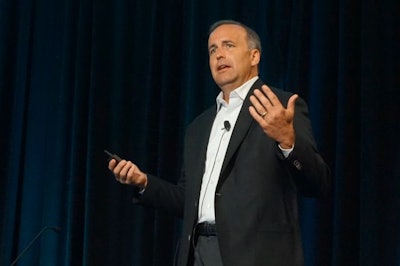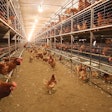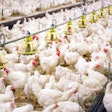
The future of chicken and protein is bright, but chicken companies and retailers will need to keep changing in order to satisfy modern shoppers.
As part of the 2019 Chicken Marketing Summit, Chris DuBois, senior vice president and principal at IRI, and Joyce Neth, vice president and director of audience development and research for WATT Global Media, shared the results of an annual survey of chicken consumers. They spoke on July 22 at the Belmond Charleston Place in Charleston, South Carolina.
The annual study monitors what drives consumers to buy chicken rather than other meat and plant-based proteins. The study was commissioned by the National Chicken Council and conducted online by IRI in July 2019. Their presentation is available online.
Among other insights provided by the survey, DuBois and Neth reviewed what they considered to be four key trends shaping the future of chicken and meat: convenience, sustainability, the growing popularity of protein and e-commerce.
Convenience and simplification
Today’s consumers need a fast, simple solution for feeding their families. Chicken can provide that solution.
Survey data shows that shoppers consider chicken to be both easy and quick to prepare. However, many lack knowledge of how to prepare the meat and need help finding recipes. Chicken companies and retailers that offer help for these time strapped and inexperienced shoppers can gain an advantage going forward.
One way retailers are helping to make cooking chicken simpler and more convenient is by providing signage and in-store devices to give consumers both recipe recommendations and directions how find the ingredients they need. These products emphasize factors like ease and speed of preparation.
Shoppers care about sustainability
Consumers are increasingly making buying choices based on how they think it might impact the environment. Data from the survey shows that products marketed on sustainability sold better than competitors. Products that are marketed as sustainable make up 16 percent of items but made up 50.1 percent of total consumer packaged goods sales in 2018.
Chicken is a sustainable choice compared with other meats, but shoppers need to be educated about this attribute. Data showed they appreciated label information about the absence of ingredients they consider to be undesirable, information about how the animal was processed, the ethical practices of the producer and its nutritional content.
Moreover, the research showed shoppers are particularly interested in emotional attributes of chicken products. In order to increase chicken consumption among those already buying chicken, DuBois and Neth said the buyer wants proof the product is raised humanely and is satisfying.
Total store protein growth
Protein is having a moment. Shoppers are looking to increase their consumption of protein and this hunger is driving up sales of products making protein claims across the store. Moreover, the data shows shoppers spend more money on products that combine protein with another health claim, such as antibiotic-free. Chicken, like other proteins, is benefiting from this trend.
At the same time, more shoppers are showing interest in plant based protein products or are trying to reduce their meat consumption for a variety of reasons. Data showed 69 percent of consumers are going without meat once a week and 28 percent are reducing or limiting their meat consumption. Accordingly, purchases of plant-based proteins are rising steadily and meat companies are now introducing blended options to satisfy this craving.
The growth of plant-based protein is small, but its development can create headwinds for animal protein producers. DuBois and Neth said 20 percent of chicken consumers who do not currently consume plant-based protein said they are open to buying it in the future.
E-commerce and new technologies
Finally, the future of retail will continued to be shaped by the proliferation of e-commerce. The click-and-collect model of online grocery shopping is expanding rapidly and online retailers like Amazon are grabbing a larger share of the edible product category.
DuBois and Neth said the path to purchase will continue to change dramatically in the future and retailers will need to push the envelope with consumer facing technology in order to survive. Stores will need to roll out what they called retail as a service technology solutions to help connect shoppers with the information they want about their food. Retail as a service programs can be used to help create a personalized shopping experience, place shoppers in a consumer loyalty program and provide them with instant coupons.
The technology can go far further. DuBois mentioned some grocers are debuting what is known as endless aisle programs – either online or in store – to display a wider range of available items than can be stocked in stores. Other stores are even using robots to help sell products, help consumers find items in the store and perform menial tasks in the store.


















